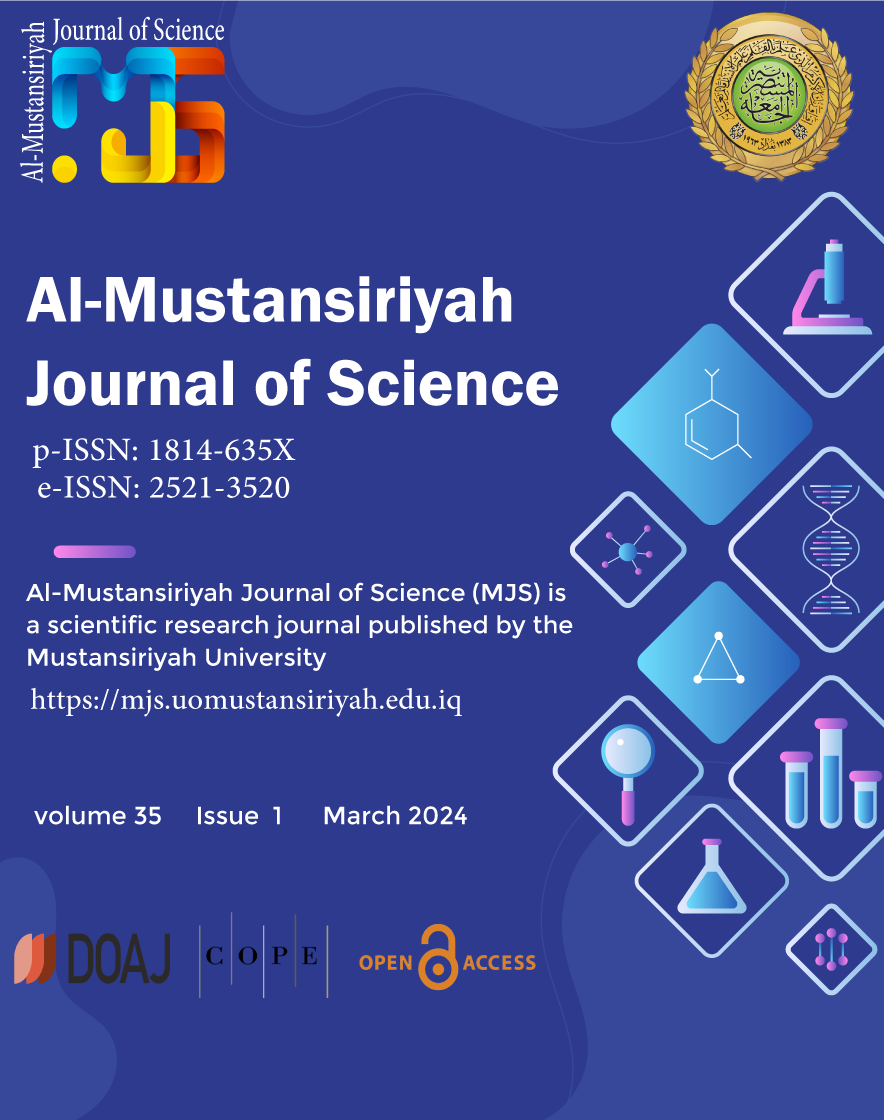The Role of Immune Check Point Gene Expression of Pd-1 and Tim-3 in Patients with Acute Myeloid Leukemia
DOI:
https://doi.org/10.23851/mjs.v35i1.1418Keywords:
Acute myeloid leukemia, T-cell immunoglobulin and mucin domain 3, Program cell death -1, Real time quantitative (qRT-PCR).Abstract
Acute myeloid leukemia (AML) is a hematopoietic cell cancer that spreads quickly to the blood and rapidly developing in the bone marrow. The prognosis for patients with acute myeloid leukemia (AML) is still poor, despite recent improvements in the therapeutic landscape. In hematological malignancies, immune checkpoint inhibitors have been studied, such as AML; however, the role of program cell death -1(PD-1) and T-cell immunoglobulin and mucin domain 3 (TIM3) in AML has not been thoroughly elucidated yet. Thus, the current study conducted to investigate the PD-1 and TIM‑3 gene expression in the AML patients and determine its associations with clinical outcomes and prognostic variables. The study collected 80 blood samples from acute myeloid leukemia (AML) patients and 40 blood samples from volunteer healthy individual were evaluated as control and real time quantitative (qRT-PCR) analysis was detect to performed PD-1 and TIM‑3 expression. The result showed there was non-significant (P>0.0001) in expression of TIM-3 in patients with AML, while expression of PD-1 statistically has high significant difference (P ≤ 0.0001). A cutoff value of PD-1 for patients vs. control was (0.853) with high sensitivity than cutoff value of TIM-3 for patients vs. control that can be diagnostically significant in distinguishing between patients and controls. Our data result showed that high expression of PD-1 in T cell is extremely correlated with progression of disease and down regulated gene expression of TIM-3 in AML patients.
Downloads
References
B. Aïnseba and C. Benosman, "Global dynamics of hematopoietic stem cells and differentiated cells in a chronic myeloid leukemia model", J. Math. Biol., vol. 62, pp.975-997,2011.
L. Xu, Y. Guo, X.-L. Zhang, J. Chen, and S. Hu, "Blood-based circulating microRNAs are potential diagnostic biomarkers for leukemia: result from a meta-analysis", Cell. Physiol. Biochem., vol. 38, no. 3, pp. 939-949, 2016.
K. A. Radhi, I. H. Hamzah, and B. F. Matti, "The role of miRNA-181C between different BCR-ABL p210 transcript levels and between different levels of imatinib optimal response in CML patients", Hum. Gene, vol. 34, p. 201128,2022.
R. H. Abdulridha, N. K. Jawad, and A. T. Numan, "Prevalence and risk of leukemia reported cases, observational descriptive statistic from Iraqi center for hematology in Baghdad province", Indian J. Forensic Med. Toxicol., vol. 15, no. 1, pp. 2428-2433,2021.
K. S. Siveen, S. Uddin, and R. M. Mohammad, "Targeting acute myeloid leukemia stem cell signaling by natural products", Mol. Cancer, vol. 16, pp. 1-12,2017.
I. De Kouchkovsky and M. Abdul-Hay, "Acute myeloid leukemia: a comprehensive review and 2016 update", Blood Cancer J., vol. 6, no. 7, pp. e441-e441,2016.
A. J. Lamble and E. F. Lind, "Targeting the immune microenvironment in acute myeloid leukemia: a focus on T cell immunity", Front. Oncol., vol. 8, p. 213, 2018.
D. M. Pardoll, "The blockade of immune checkpoints in cancer immunotherapy", Nat. Rev. Cancer, vol. 12, no. 4, pp. 252-264,2012.
T. Yamamoto et al., "Surface expression patterns of negative regulatory molecules identify determinants of virus-specific CD8+ T-cell exhaustion in HIV infection", Blood, J. Am. Soc. Hematol., vol. 117, no. 18, pp. 4805-4815, 2011.
A. C. Anderson, N. Joller, and V. K. Kuchroo, "Lag-3, Tim-3, and TIGIT: co-inhibitory receptors with specialized functions in immune regulation", Immunity, vol. 44, no. 5, pp. 989-1004, 2016.
Y. Cao et al., "Tim-3 expression in cervical cancer promotes tumor metastasis", PLoS One, vol. 8, no. 1, p. e53834,2013.
J. Jiang et al., "Decreased galectin-9 and increased Tim-3 expression are related to poor prognosis in gastric cancer", PLoS One, vol. 8, no. 12, p. e81799, 2013.
N. L. Syn, M. W. L. Teng, T. S. K. Mok, and R. A. Soo, "De-novo and acquired resistance to immune checkpoint targeting.", Lancet. Oncol., vol. 18, no. 12, pp. e731-e741, Dec. 2017.
T. Okazaki, S. Chikuma, Y. Iwai, S. Fagarasan, and T. Honjo, "A rheostat for immune responses: the unique properties of PD-1 and their advantages for clinical application", Nat. Immunol., vol. 14, no. 12, pp. 1212-1218, 2013.
T. D. Schmittgen and K. J. Livak, "Analyzing real-time PCR data by the comparative CT method", Nat. Protoc., vol. 3, no. 6, pp. 1101-1108, 2008.
M. S. Harani, S. Adil, M. U. Shaikh, G. N. Kakepoto, and M. Khurshid, "Frequency of fab subtypes in acute myeloid leukemia patients at Aga Khan University Hospital Karachi", J. Ayub Med. Coll., vol. 17, no. 1, p. 26, 2005.
H. A. Ahmed, A. M. Maklad, S. A. A. Khaled, and A. Elyamany, "Interleukin-27 and interleukin-35 in de novo acute myeloid leukemia: expression and significance as biological markers", J. Blood Med., pp. 341-349, 2019.
Y. Ruan et al., "Clinical Implications of Aberrant PD-1 Expression for Acute Leukemia Prognosis", 2022.
Y. Wolf, A. C. Anderson, and V. K. Kuchroo, "TIM3 comes of age as an inhibitory receptor", Nat. Rev. Immunol., vol. 20, no. 3, pp. 173-185, 2020.
K. Sakuishi, L. Apetoh, J. M. Sullivan, B. R. Blazar, V. K. Kuchroo, and A. C. Anderson, "Targeting Tim-3 and PD-1 pathways to reverse T cell exhaustion and restore anti-tumor immunity.", J. Exp. Med., vol. 207, no. 10, pp. 2187-2194, Sep.2010.
J. Hong et al., "TIM-3 Expression Level on AML Blasts Correlates with Presence of Core Binding Factor Translocations Rather Than Clinical Outcomes.", Front. Oncol., vol. 12, p. 879471, 2022.
Downloads
Key Dates
Received
Revised
Accepted
Published
Issue
Section
License
Copyright (c) 2024 Al-Mustansiriyah Journal of Science

This work is licensed under a Creative Commons Attribution-NonCommercial 4.0 International License.
(Starting May 5, 2024) Authors retain copyright and grant the journal right of first publication with the work simultaneously licensed under a Creative Commons Attribution (CC-BY) 4.0 License that allows others to share the work with an acknowledgement of the work’s authorship and initial publication in this journal.






















